Spotify Makes Minty Fresh New Home For EDM
While many popular dance music genres have risen up and flared out in a relatively brief span of time EDM appears to, in many ways, be hanging on better than most thanks in part to the carefully curated mint playlist on Spotify, currently the streaming platform's sixth most popular of all its playlists.
____________________________
Guest post by Jason Joven of Charmetric on Medium
Chartmetric data as of: Jan 3 2018
“It’s an evolution. The thing is that, every musical genre starts from the underground, gets trendy, then it becomes popular, and then it dies or it is reinvented in a different way…” — David Guetta, EDM global superstar (via CNN’s Abel Alvarado)
The beginning of 2018 is an interesting time to look back at the $7.4 billion industry known as electronic dance music, or as the branding world likes to call it: “EDM”. Purists may hate the term, and the reasons may lie in the inevitable arc of any “cool” thing, as Guetta himself notices above. A Google search on “EDM popularity” simultaneously reveals a 2012 “The Rise of EDM” Huffington Post article, a 2014 “How Did EDM Get So Popular?” CNN piece, and then Miami New Times’ foreboding “Will EDM Survive Beyond 2017?”
Birth, growth, death.
While ragtime, jazz, singer-songwriter activism, disco, 80s hair bands, punk, grunge may be alive and well in their inner circles, they’ve all since abdicated their pop culture thrones. They’ve long been where EDM might otherwise be today. But if Spotify’s RapCaviar playlist has anything to do with its 40-odd-year genre refusing to die…maybe Spotify’s mint (lower-case stylization on purpose) can do the same for dance and electronic music. As the streaming platform’s #6 most popular playlist with 4.6 million followers, EDM’s proverbial ship might still be on course.
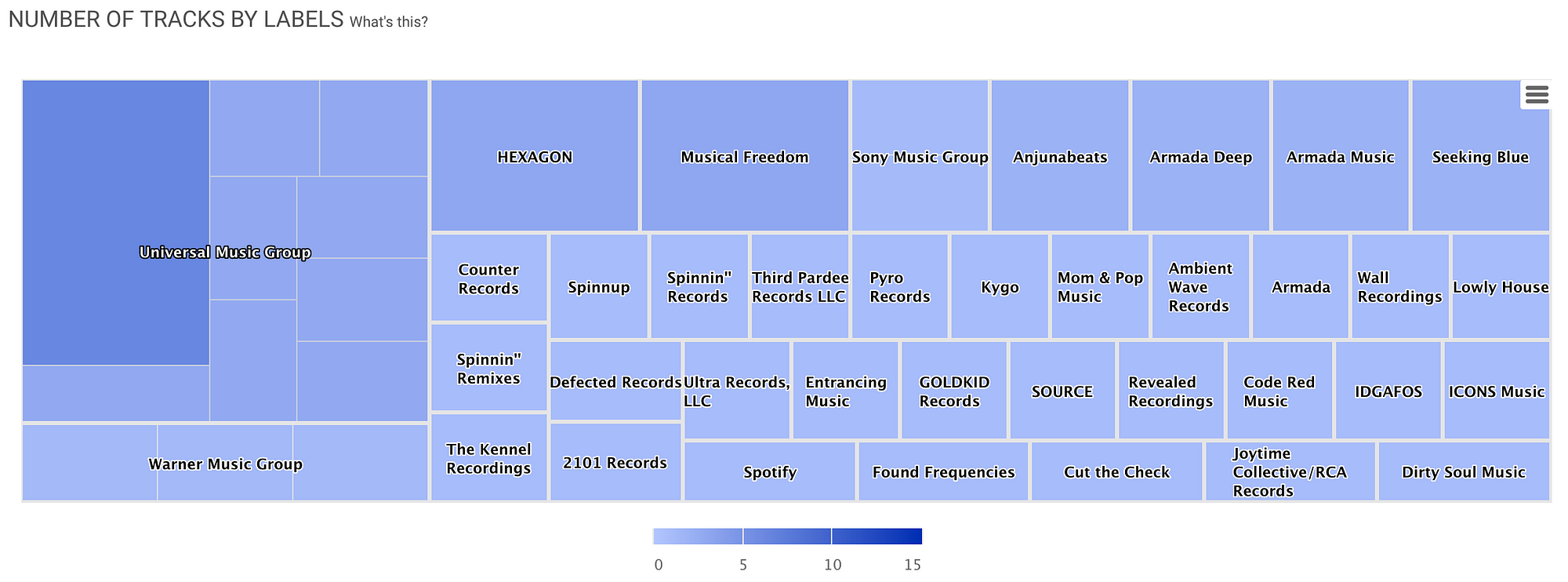
No Button-Pushers, Please
mint is the lead electronic music playlist in Spotify’s ecosystem, and is the result of the Aug 2017 re-branding of its electroNOW playlist. It is the EDM flagship in the pantheon of Spotify sub-brands that are now using vertical mobile-optimized videos, exclusive artist content, and radio-bred curators to leverage Spotify’s current streaming dominance (35% of the streaming subscriber market share) into other lines of business such as live concert touring.
Under the watch of Global Head of Dance & Electronic Music Austin Kramer, mint exhibits several unique traits among the Spotify’s biggest playlists (Today’s Top Hits is currently #1 at 18.5 million total followers). More interestingly, mint’s distinct digital signature echoes the independent, experimental spirit that electronic music was originally known for.

mint usually updates every Friday, like most of its playlist cohort, but it diverts from the herd with a much more free-wheeling curation style. Though prior to its August rebranding, it kept to a static 50 track total, it now has a much more flexible playlist count (45–66 tracks at any given time), and even features a Google Form submission link that lives on Kramer’s Twitter profile. Anyone can submit to it, and according to Kramer, he listens to every track:
“After I get submissions, I go through them all and I try and find a space for them…that’s my promise to any label, manager, artist, or promoter…[I] make sure that we have a spot for it and culturally, we’re not missing anything…after the tracks are in, the audience decides whether it stays or goes.” — Austin Kramer (via Sam Matla’s EDM Prodcast)
This open-door submission policy is a breath of fresh air answering the sole question modern independent artists flood Internet forums and industry panels with: “How can I get on a Spotify playlist?”
While the jury is out on how many of the tracks Kramer and his team actually get through each week (as a comparison: SubmitHub, a popular music blog submission portal, has taken in 1.3 million tracks between late 2015-mid 2017), Spotify has arguably replaced radio as the breaker of new artists. And if mint is doing its job with new talent, it will be “incredibly diverse and ever-fresh”, as it did with rising EDM producer ZHU upon mint’s premiere.
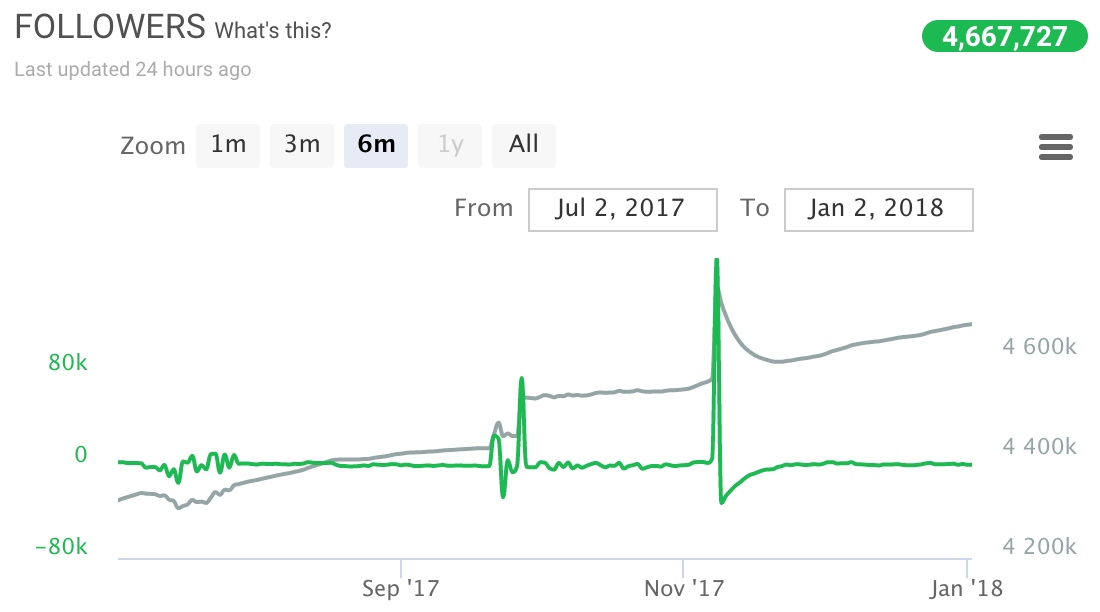
As the sixth most popular playlist, mint has shown a solid median Spotify follower growth of ~2200 per day. While not the ~7700 per day numbers that RapCaviar is seeing, we do note an interesting drop after its rebranding in Aug 2017 to mint. As electroNOW (Feb-Aug 2017), it saw a higher median at 2936 per day. After becoming mint (Aug-Dec 2017), it dropped to a mere third to 981 per day. Now correlation is not causation, and the re-branding may have nothing to do with the drop in follower count. But I propose that, like any genre who is past its initial mainstream phase, maybe this follower drop suggests a return to electronic music’s diehard fans, not just hangers-on who just came to party on the weekends, as the above Miami New Times article suggests.
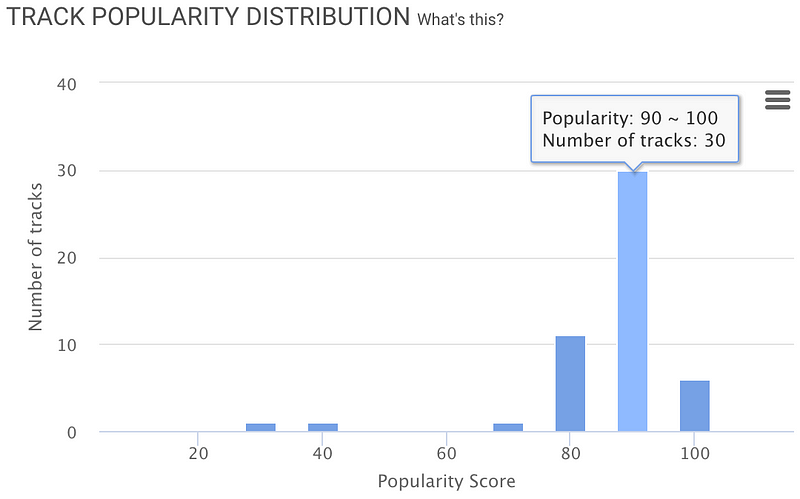
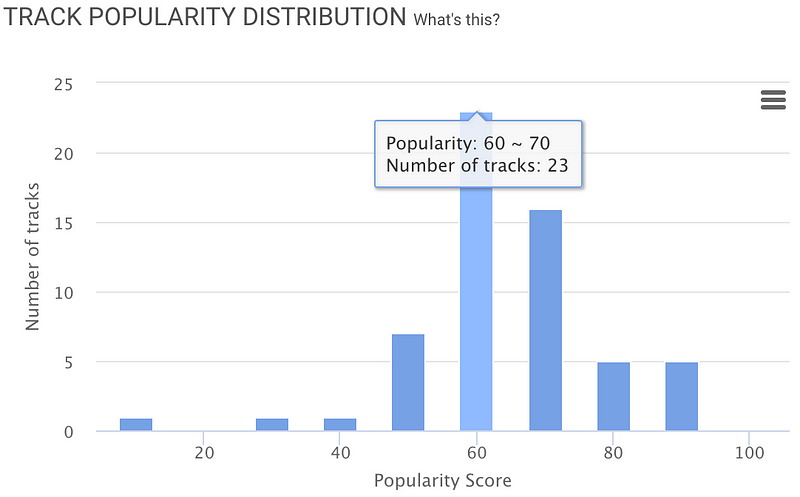
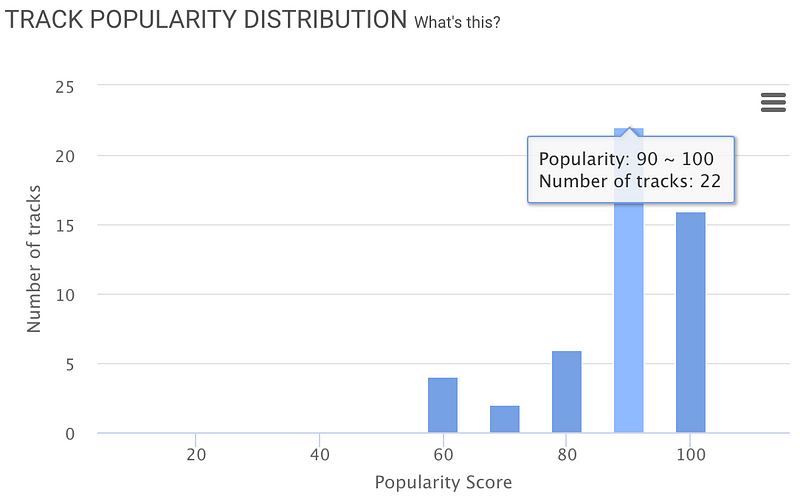
Another data point of interest is mint’s lower popularity scores in its Current Tracks. Today’s Top Hits and Viva Latino! both feature Current Tracks that focus on Spotify’s 90–100 range, while mint exists in the 50–70 range.
It would be rather shallow to think that the lower overall popularity is “bad” for dance music in general. First, consider that Spotify’s popularity rating is dynamic and limited to its platform. The genre still lives in its original strongholds at SoundCloud and Beatport. Also, as electronic music has its roots in experimentation (check out Alvin Lucier’s “I Am Sitting In A Room” for his 1981 banger), maybe it’s not supposed to be popular, track by track. And third, EDM is a continuous, hours-long experience…it’s relatively much less reliant on singles, star vocalists or fashion statements, than it is with label reputations, proven event promoters, or trusted producers. As Kramer notes, dance music is about what’s new, and instead of paying it lip service and just posting up Big Three label artist releases, he actually tries to spotlight unknown material.
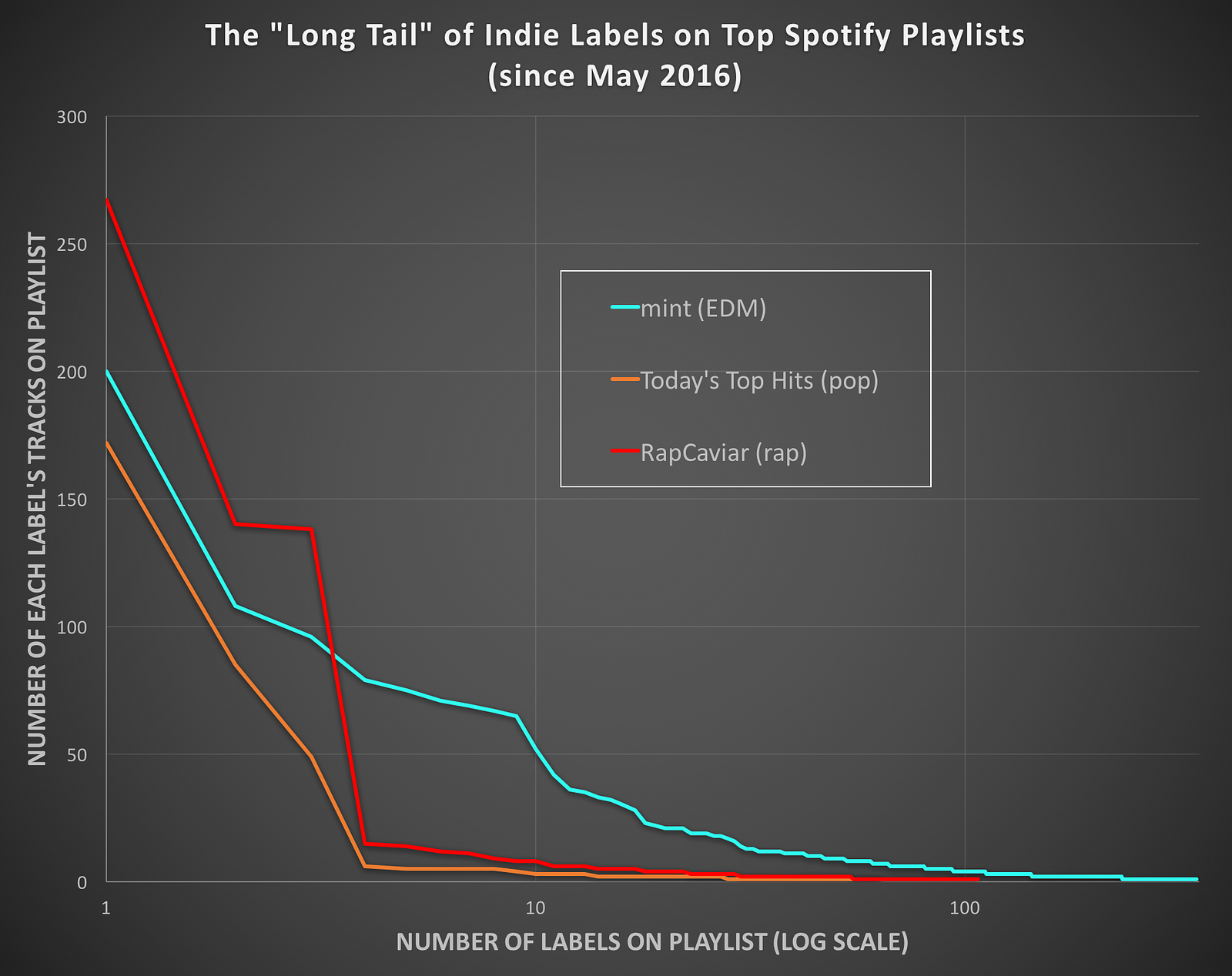
mint’s rebel streak continues via its “long tail” of labels in the historical tracks. When charting the amount of labels against the amount of tracks that have appeared on mint (or electroNOW, pre-Aug 2017), there’s a much more equitable distribution than what we see in Today’s Top Hits or RapCaviar. It recalls Chris Anderson’s idea of the “long tail” and how the Internet would enable a wider diversity/depth of products to satisfy more unique tastes among consumers, rather than just a small percentage of mainstream ones serving all.
For example: on Today’s Top Hits (pop), the top four labels and their charting tracks place like this: Universal (172), Sony (85), Warner (49), Big Machine Records (6). For RapCaviar (rap), Universal (267), Sony (140), Warner (138), Quality Control Music (15). For mint (EDM): Universal (200), Warner (108), Sony (79), and then UK’s Anjunabeats (75). And that number lowers much slower as the labels increase in mint.
You’ll see that front end of the other two playlist drop off quickly after the Big Three labels have their say. But with mint, there is a very alive “middle” class of record labels that are contributing and Kramer is encouraging the competition. Note that there were 345 labels represented on mint, compared to the 63 on Today’s Top Hits and 107 on RapCaviar. From a creative perspective, this can only create a diversity of sound that must be good for the genre’s evolution.
“There really isn’t anything he doesn’t know about electronic music culture; everyone in that world knows Austin.” — Spotify CEO Daniel Ek (via Music Business Worldwide’s Tim Ingham)
Last but not least is Kramer’s credibility as Spotify’s electronic music czar, and by proxy, mint’s credibility as a flagship dance music playlist. Due to his extensive industry network from his SiriusXM days (eight years in total: programming for Electric Area/Tiësto CLUBLIFE & music direction for the BPM channel), his knack for promoting new sounds directly translates into mint’s track selection so well that, as we’ve seen, it reflects in the data. It will be exciting to see what his palpable passion will do for Spotify’s community and the genre in general.
Wait for the Drop…
To say mint is a unique playlist by the numbers would be true, but that’s merely a symptom of what we should really understand. Electronic music, dance music, EDM- whatever you prefer calling it- is its own culture, and one that is universal in a way that seems relatively immune to the boundaries of nation-state borders or language, due to its relatively non-existent need for lyrics. It still lives and breathes in underground sweaty clubs, on SoundCloud via a hopeful bedroom producer’s uploads, and of course in massive EDM festivals like Tomorrowland that mainstream fans are aware of.
Yes, corporations have had their way with EDM, and made a select few artists millionaires, but that doesn’t mean that it’s curtain call. The future of any genre is ultimately a product of their communities, and in large part, their leaders. With the world’s biggest streaming platform choosing the “real deal” in a lifer like Austin Kramer, one thing seems to be sure: whatever EDM’s future is, one of its captains is ready to keep watch.
Peace, love, unity, respect….if you enjoyed, please lay on that Medium clap button below to show it! Also, reach out to us at hi (at) chartmetric (dot) io.